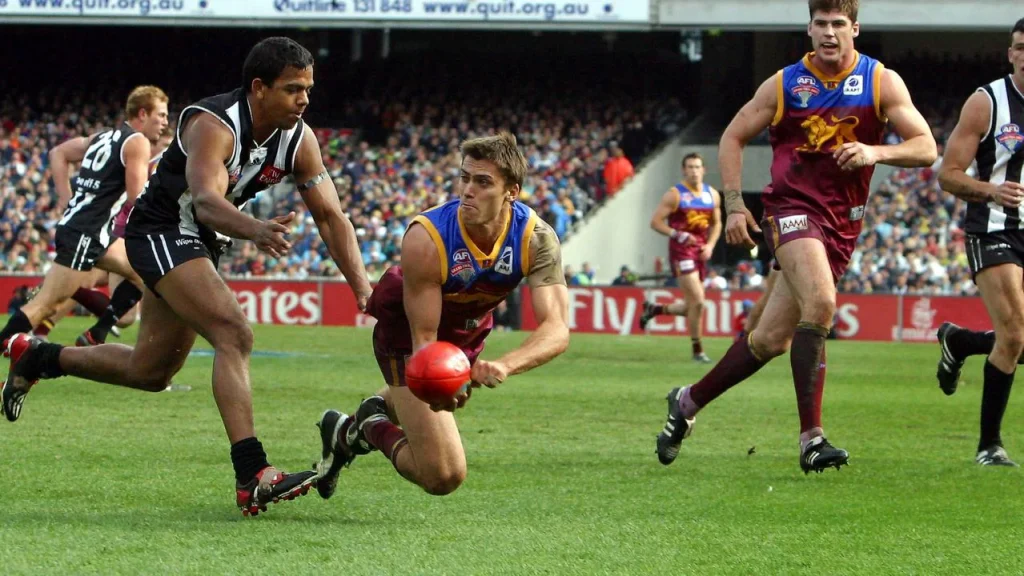Despite its name, Australian Rules Football (Aussie Rules) has very little in common with classic European football. It is something in between rugby and basketball, with its own dynamics, logic, and character. To understand why the game evokes such powerful emotions in millions of fans on the green continent, it is important to delve into the essence: from the history to how the rules of Australian football are structured.
The discipline is not just a sport, it is a true cultural value of Australia, reflecting the local spirit, attitude towards physical activity, and national unity. The modern format of the game impresses with its energy, tactical depth, and pace.

Origin and History of Australian Football
Its history dates back to the mid-19th century. Initially conceived as a sporting pastime for cricketers in the off-season. The first official game was played in Melbourne in 1858, and a few decades later, the Australian Football League (AFL) was formed — the main structure governing the competitions.
Over time, the game acquired its unique features, distinguishing it from other ball sports. Today, it is recognized as one of the most spectacular and popular sports in Australia, with a powerful infrastructure, a system of youth academies, and a huge army of fans.
What is Australian Football: Key Rules
 Contrary to common belief, Aussie Rules is not rugby. It has its own format, and the difference between Australian football and rugby lies in both the field shape and the player interaction system. The basis of the game is to move the oval ball to score between the central or side goals.
Contrary to common belief, Aussie Rules is not rugby. It has its own format, and the difference between Australian football and rugby lies in both the field shape and the player interaction system. The basis of the game is to move the oval ball to score between the central or side goals.
The field for Australian football is oval, its length can reach 185 meters, and the width — up to 155 meters. There are 18 players from each team on the field at the same time, each performing a specific tactical task. The match consists of four quarters of 20 minutes of “clean” playing time, ensuring a high pace with minimal breaks.
Scoring Structure and Goal System
One of the main rules of Australian football is the scoring system. Players aim to kick the ball between two tall posts in the center — this earns 6 points. Getting the ball between one of the central and side posts earns 1 point. This format requires attacking players to be highly accurate and coordinated. To better orient yourself, remember:
- 6 points are awarded for scoring in the central goals;
- 1 point is awarded for scoring in the side goals;
- a penalty kick is awarded for a serious violation or foul in the attacking zone.
Thus, scoring in Aussie Rules depends not only on the number of attacks but also on the accuracy of execution.
System of Violations and Penalty Kicks
Like in any other league-based sport, strict rules of Australian football apply regarding contacts, blocks, and holds. Referees monitor not only the roughness of play but also the moment of passing, the opponent’s position, and the correctness of ball handling.
Serious violations lead to the awarding of a penalty kick, and repeated incidents result in a player being sent off the field, ensuring a balance between toughness and safety.
Differences Between Aussie Rules and Other Sports
The main difference between Australian football and rugby is the complete freedom of movement and physical contact in open space. A player can run with the ball, kick or handball it, pass it in the air, or deliver a precise pass, but each step requires lightning-fast decisions.
This versatility is not accidental — the rules of Australian football presuppose a dynamic game that requires full dedication both physically and mentally.
How to Play Australian Football: Getting Started for Beginners
For those who want to master the sport, it is important to learn the basic principles and understand the dynamics. Beginners will find it useful to familiarize themselves with the basics before taking to the field.
- familiarize yourself with the AFL rules — the official league;
- study the field layout and player positions;
- start with ball passing drills with feet and hands;
- develop endurance — physical fitness is crucial here;
- participate in local matches and amateur clubs.
This approach will allow you to quickly immerse yourself in the game, feel its rhythm, and understand how to play Australian football even without much experience.
Tactical Elements and Team Behavior on the Field
Each team develops its tactics considering the opponent’s characteristics, weather conditions, and field conditions. Players quickly move between positions, execute complex passes, actively use their body and space. This movement requires an understanding of the game, excellent coordination, and teamwork.
Tactical rotation and the struggle for space are key elements on which the rules of Australian football are based, combining toughness and intelligence.
How to Understand the Rules of Australian Football: Tips for Spectators
To start enjoying watching matches, it is important to understand the structure of the game and the teams’ specifics. Below are some recommendations for those who are just getting acquainted with the sport:
- choose one or two leagues to follow conveniently;
- start watching games with commentary — it speeds up adaptation;
- pay attention to tactical adjustments during matches;
- learn the terminology — it helps better understand players’ actions;
- engage with the community — Aussie Rules is valued for its friendly fan atmosphere.
Even if you have never been to a stadium in Melbourne, you can enjoy the game from anywhere in the world.

Now You Know All About the Rules of Australian Football
 At first glance, the sport may seem chaotic, but once you delve into the rules of Australian football, the structure becomes logical and understandable. Everything here is built on a balance of strength and tactics, speed, and calculation.
At first glance, the sport may seem chaotic, but once you delve into the rules of Australian football, the structure becomes logical and understandable. Everything here is built on a balance of strength and tactics, speed, and calculation.
Understanding the nuances — from field markings to the scoring system — allows you to truly appreciate the scale of the game. Therefore, the more you learn about Aussie Rules, the more reasons you have to include it in your list of sporting interests — as a spectator, a player, and an explorer of vibrant sports cultures.
 en
en  de
de  ar
ar  es
es  nl
nl  hi
hi  fr
fr  it
it  pt
pt  el
el 










